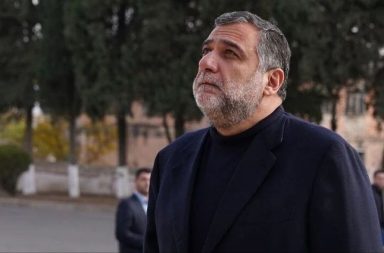by Charles Lampson
During a meeting with UN Secretary-General António Guterres, the Chairman of the Caucasus Muslims Board, Sheikh-ul-Islam Allahshukur Pashazadeh, once again made accusations against the Mother See of Holy Etchmiadzin.
“In the current situation, when the political leaderships of Azerbaijan and Armenia are making efforts to build peace in an atmosphere of constructive cooperation, the Armenian Church and the Diaspora are carrying out destructive propaganda aimed at disrupting that process. While the political leaders of both countries are taking steps toward peace, the Armenian Church is calling for revanchism and renewed clashes,” Pashazadeh continued in his delusional remarks.
The Azerbaijani cleric also attempted to portray the destruction and appropriation of Armenian cultural heritage in Artsakh as “restoration work.” This is a common line of rhetoric from Azerbaijan in its systematic erasure of centuries-old Armenian Christian heritage from Artsakh, as the government of Azerbaijan claims it is “restoring” the sites in their original form. This claim has no historical backing whatsoever, and rests on a demonstrably false assertion that Muslim predecessors to ethnic Azeris were in fact the original inhabitants of Artsakh and the original constructors of what “later” became Armenian Christian holy sites. The Armenian kingdom adopted Christianity as its state religion in A.D. 301, and this kingdom included the territories of Artsakh. Armenian Christian churches were thus already being built in Artsakh during the fourth century, no less than 300 years before Islam even came into existence.
Armenian organizations have consistently attempted to combat anti-Armenian narratives propagated from Azerbaijan, though these narratives still often receive prominent audiences, such as when an Azeri delegation recently visited the Vatican or in the Azeri meeting with the UN Secretary-General. In response to the statement by the Caucasus Muslims Board, the Armenian Apostolic Church issued the following scathing rebuke:
“During a recent session of the Council of Qadis held in Baku, Sheikh ul-Islam and Head of the Caucasus Muslims Board, Allahshukur Pashazade, once again assumed the role of disseminator of Azerbaijani disinformation and lies, targeting the Armenian people and the Armenian Church with hatred and hostility.
Surpassing even his previous fabrications, Pashazade claimed that the centuries-old Armenian sanctuaries in Armenia and the region — including the 1700-year-old Mother Cathedral of Holy Etchmiadzin — allegedly lie on “historical Azerbaijani lands,” and that Armenians have purportedly “appropriated” these territories. He concluded this series of absurd assertions by portraying the Armenian Apostolic Church as a threat to the countries of the region.
It is profoundly absurd that the spiritual leader of a people who received the ethnonym “Azerbaijani” only in the latter half of the 1930s as a result of Soviet nation-building policies, would attempt to challenge the historical presence of the Armenian people – a presence marked by millennia of creative life and spiritual-cultural heritage that is universally recognized and respected around the world. Even more paradoxical is that such accusations of appropriation are voiced by a representative of a state whose very name was itself appropriated from another people and land.”
The notion of Armenian territory being “historically Azerbaijani land” is primarily derived, inasmuch as it has any minimal historical basis at all, from the fact that some Muslim Caucasus people, generally known before the Soviet era simply as “Caucasus Tatars”, did indeed live in territories currently comprising the Republic of Armenia. However, much larger numbers of ethnic Armenians lived in territories currently controlled by Azerbaijan, including a very large Armenian presence in Baku, in Nakhichevan, and of course in Nagorno-Karabakh. Azerbaijan uses the fact that some Muslims lived in Armenia to claim the entire country, while completely erasing the historical reality of massive Armenian Christian presence in what is now Azerbaijan. Moreover, the Armenian Church’s statement correctly points out that even the name Azerbaijan was not assigned to that territory until the era of the Bolsheviks.
Azeri propaganda narratives denying the overwhelmingly obvious historical reality of Armenian Christian presence in Artsakh and other narratives are too ridiculous to be taken seriously by any historical scholars. However, these narratives may become threatening to the Armenian Church if they are deployed against the Church in tandem with social engineering from the Pashinyan government that may seek to use any narrative, even Azeri ones, to dissuade loyalty to the Church. Pashinyan’s anti-Christian campaign has continued to escalate, as seven Armenian Apostoolic priests were arrested this morning and detained for questioning by the authorities.


